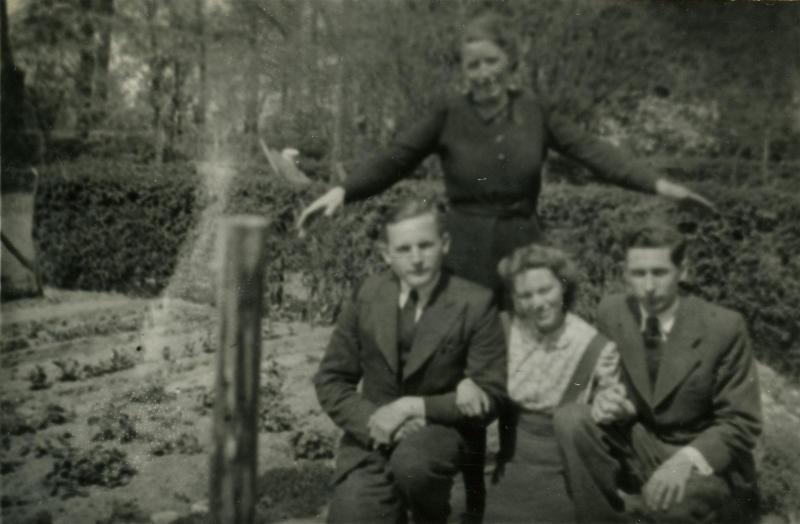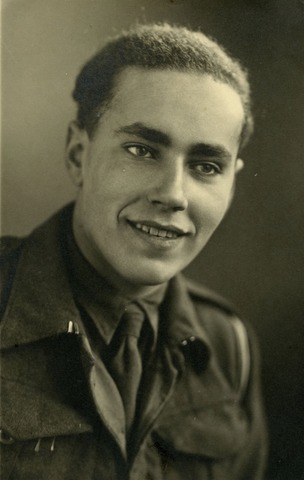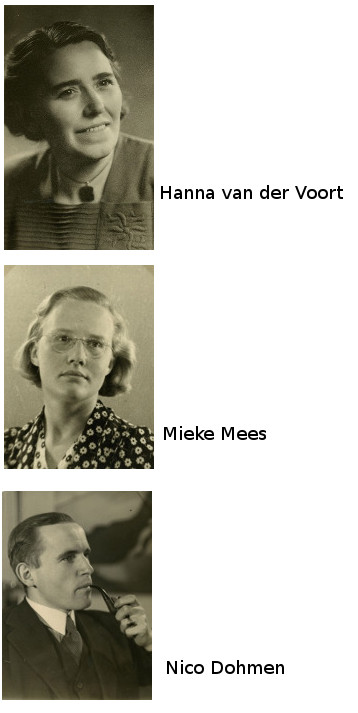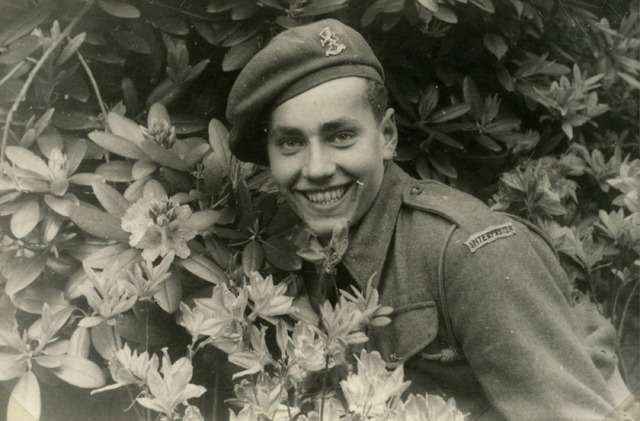November 17, 1925 - May 8, 2017
Introduction
On May 11 1940 Curt would board the ship SS Veendam in Rotterdam, together with his parents and older brother Heinz, to start a new life in the United States. However, fate decided otherwise. On May 10 the Germans invaded the Netherlands and the Dutch police immediately started to arrest German Jews who had fled to the Netherlands. Among them was the Löwenstein family. A life in freedom seemed to remain an illusion for good.
Despite the dangers for the Jewish people in the Netherlands, Curt wasn’t the type of person to wait for the end of the war in hiding. As soon as an opportunity presented itself, the barely 17 year old boy joined the Dutch resistance and saved the lives of a great number of Jewish children. Also he aided two airmen of the American Army Air Corps.
This is the interesting story of Curt Lowens, the man who made a name for himself as an actor and movie star, but whose role during the war as Ben Joosten, Ben Oudenbosch or Ben Schräder remained underexposed.
Previous history
Curt Lowens was born on November 17 1925 in Allenstein, East Prussia, as Curt Löwenstein in a Jewish family in which an older son, Heinz, had already been born in 1923. It was a loving and active family. Mother Ellie was active in various local organisations and father Alfred was a respected lawyer and a good amateur piano player. But least of all would it become a careless childhood for both boys. Anti-Semitism was on the rise quickly and in 1933 Adolf Hitler (Bio Hitler) came to power. The attitude towards Jews became evermore grim. The parents tried to let their sons grow up in a protective environment, but that became more difficult by the day. In 1935 the Nuremberger Laws or anti-Jewish laws came into effect and the consequences were noticeably felt by the family. At the public school, which was attended by only 5 Jewish children (among them the Löwenstein brothers), the children were called names by classmates and Curt was even beaten up. Soon, his father was known as the ‘Jewish’ lawyer and therefore was no longer welcome at court, which caused Alfred Löwenstein to lose his clientele. There was nothing left but to close his practice. Ellie’s parents, Curt’s great parents, owned a shoe shop which they had to sell for very little money.
In 1936 Alfred came up with the idea of moving to Berlin. A large Jewish community was living there and he hoped that this community would be able to protect his family. He succeeded in finding a job as a lawyer and the boys attended their new school, the Goldschmidt Schule. This time the parents had chosen a Jewish school. Life returned to normal and for a while it seemed that the danger was gone.
But in Berlin the atmosphere soon became more hostile as well. Violence increased dramatically and the big eruption took place on November 9 1938. In the afternoon Curt was again called names and this time he was pelted with stones by members of the Hitler Jugend (Hitler Youth). In the evening the synagogue, which he always attended, was set ablaze and his Bar Mitzvah therefore couldn’t be celebrated. More synagogues fell victim together with shops of Jewish owners. An enormous wave of violence, aimed against the Jews, raged through Berlin and other German cities that night. This explosion of violence would become known as the ‘Kristallnacht" (Night of the Crystalls). For Curt the worst event was the arrest of his father. Alfred Löwenstein was immediately deported to concentration camp Sachsenhausen.
Farewell Germany
Curt’s mother, Ellie Löwenstein, tried to get her husband released. She told the authorities the family planned to emigrate to the United States. After three weeks Alfred was released and he returned to Berlin. but the family didn’t feel at home anymore in the capital. They wanted to leave Germany as soon as possible, but emigrating wasn’t that simple. First of all it was a costly enterprise, as payment had to be made in US dollars. Furthermore a long bureaucratic road had to be taken in order to get all the paperwork done.
Since many Jewish families wanted to emigrate, English classes were already given at the Goldschmidt Schule. This was a huge advantage for his brother Heinz, who was given the chance a year later to emigrate to England, together with 15 other boys. His parents and brother Curt remained in Berlin, awaiting their visa. At the beginning of May 1940 the moment was finally there and the Löwensteins left for Rotterdam by train, where they would embark on the SS Veendam to leave for the United States.
However, on May 10 1940 the Germans invaded the Netherlands and almost immediately the Dutch authorities issued an order to run in any suspicious person who could be a threat to Dutch society. At first this applied to persons from Germany or the territories occupied by the German Empire. The ministries of Justice and Defense already cooperated in 1939 to put together a list of persons to be interned, in order to increase state security. Among those persons were also Dutchmen who were considered to be disputed. Special attention was paid to members of the NSB and German nationals.
When the Germans actually took power, a chaotic situation arose in which many innocent people became victim of random arrests. At that moment over 30,000 German-Jewish refugees were living in the Netherlands. The police immediately started to arrest as many Jews as possible in Amsterdam, Rotterdam and The Hague and transferred them to several holding sites. In Rotterdam about 700 people were arrested, among them the Löwensteins. The men were taken to the building ‘De Doelen’, the most important holding site. The women were taken to several police stations. Another place where Jewish prisoners were held, was the steamer ‘Baloeran’, property of the Rotterdamse Lloyd. At first the prisoners were made to believe they had nothing to fear and that they would be released soon. This promise was difficult to accept by the refugees who thought they would be safe in the Netherlands. It was also a promise impossible to keep.
On May 14 1940 the city was hit by a huge German bombardment (Rotterdam 1940) and its entire centre was destroyed. Many people were killed. ‘De Doelen’ was also hit and 400 prisoners died. The Löwenstein family was among the survivors, but their dream of living in freedom was definitively smashed with the arrival of the Germans.
The forced stay in the Netherlands
The Löwensteins were evacuated to Venlo and Curt found a job as an apprentice in an electro shop. When father Alfred was offered a clerical job in 1942 on the Jewish Council, headed by Abraham Asscher and David Cohen, the whole family moved to Amsterdam, hoping for better days. But those never came.
One day while Curt and his mother were on the street, the neighborhood was sealed off unexpectedly. A razzia was held, Jews were being rounded up and taken to Westerbork: final destination Auschwitz. Among the arrested were Curt and his mother. The stamp in their papers, given because of Alfreds work at the Jewish Council, should protect them against deportation, but it was ignored. After two weeks the commander of camp Westerbork decided to yet respect the stamp and he allowed Curt and his mother to return to Amsterdam. That freedom however wouldn’t last long.
Two months later the entire Löwenstein family was (arrested) picked up and deported to Westerbork. After a stay of six weeks they were released again, thanks to Alfred’s connections. On coming back to Amsterdam they found their apartment completely emptied by the Puls firm and Alfred came to the conclusion it would be better to go into hiding. Ellie Löwenstein however had fallen ill and Alfred had no other choice than to take his wife to a Jewish hospital. Next he found a hiding place at some friends’ place for his son and himself in an attic .
Amsterdam wasn’t safe for Curt however. Except being Jewish, he also belonged to an age category, which made him eligible for forced labor in Germany, even if his Jewishness would go unnoticed. Via the student’s resistance movement, in the person of Mieke Mees, he was brought to an address in Venlo. He was also given a new identity, the first alter ego in his long life: Ben Joosten, a village teacher. Not long after this Curt went to Tienray, where he found shelter at Antoon "Toontje" Peters’place, a blacksmith and member of the resistance. Because of safety measures he would switch (change) addresses several times.
In the resistance
Toontje Peters was member of a group built around Hanna van de Voort, Nico Dohmen, a student from Nijmegen, was also a member. Hanna was a midwife and as such held numerous connections. She was asked by the Meerburg-group, a student resistance group led by Piet Meerburg from Amsterdam, to help hiding Jewish children and soon Tienray became a regional headquarters of the Meerburg-group. Curt worked on a farm when he became acquainted with Hanna van de Voort and Nico Dohmen. Because of them he decided to join the resistance.
Together they brought Jewish children to safety and afterwards they often visited the foster parents in order to supply them with ration tickets, clothes, shoes and food. For safety reasons, the children had to be relocated from time to time, what was also done by Curt, often together with Nico. The lives of 123 children and several adults were saved, thanks to them, but their work would not be limited to saving Jewish children alone.
In August 1944 Curt was cycling in the countryside, when he heard an enormous rumbling above him. He watched an American plane crash in a meadow, followed by two parachutes coming down. He hurried to the place as fast as possible which was still quite a distance from him. Once arrived, farmers were already busy clearing away the parachutes and they had hidden the airmen in a haystack. Curt took the airmen, who belonged to the Army Air Corps, and hid them in the woods. Late in the evening he collected them and hid them in his own hiding place, the attic of the Moorens family. The pilots stayed at various (different addresses) locations until the liberation on October 17 1944.
Since his departure from Amsterdam, Curt had had no contact with his father. He even didn’t know whether his father was alive or not. Until the beginning of December 1943. It was Nico Dohmen who told him his father had gone into hiding in Venlo and that his mother was taken care of by nuns in a Catholic hospital in Tegelen. She was seriously ill. Curt succeeded in visiting his mother once before she died in January 1944.
Going into hiding wasn’t without danger and that became apparent in Tienray once again. During the night of July 31 and August 1 1944, the Gestapo searched several houses, after having been informed there were Jews in hiding. One of those addresses was the hiding place of Curt himself, but at the moment of the search he wasn’t there. The Gestapo arrested 7 children and 2 adults, who had been in hiding there. The prisoners were put on transport to Auschwitz immediately. But the Gestapo made yet another prisoner: Hanna van de Voort. After 9 days of intensive interrogations she was released, having to deal with health issues for the rest of her life as a consequence of those interrogations.
In British service
While the north of the Netherlands would have to wait a long time for its liberators, the liberation of the south started at the end of 1944. From there the advance would go to Berlin. On an early November morning in Tienray the local priest called for Ben. Curt, together with his father and 16 others, was hiding in a cellar. On the question why Curt was called for, the priest answered that an interpreter was urgently needed, because outside 3 English soldiers were waiting. They were members of a military detachment of the British government. Curt came out and offered his services. When the soldiers discovered this Ben did not only speak English and Dutch, but German as well, they immediately offered him a job as an interpreter. Curt was given a British uniform and followed the British 8th Corps into Germany, where war still was raging. In this way he became the liaison between the military and the local people.
After the capitulation in the spring of 1945 Curt, still as an interpreter, went to castle Glücksburg, about 7,5 miles northwest of Flensburg with two English officers. It was May 8 and the castle housed a well known resident at that time, Albert Speer, minister of Armament. He was there not without reason. The new military supreme command was located in Flensburg by order of Großadmiral Karl Dönitz (Bio Dönitz). After Adolf Hitler’s death Germany seemed to be ungovernable, but prior to his suicide Hitler (Bio Hitler) had named Dönitz in his political testament as his successor. As soon as Dönitz had taken charge, he relocated the military supreme command to Flensburg. A heavily guarded navy complex was located in the port, familiar territory for the Großadmiral. Feldmarschall Wilhelm Keitel and General Alfred Jodl, (Bio Jodl) both from Hitler’s general staff, were subordinate to Dönitz from that moment on.
Meanwhile the Großadmiral wanted to form a new government and within a short time Flensburg teamed with high ranking Nazi’s, among them Reichsführer-SS Heinrich Himmler (Bio Himmler), minister of state for the occupied eastern territories Alfred Rosenberg (Bio Rosenberg) and the camp commander of Auschwitz, Rudolf Höss (Bio Höss). Despite the capitulation the government led by Dönitz remained in office, against the will of the Russians. The English and Americans arrived in Flensburg in the beginning of May. In Germany they were uneasy with their new situation, since there they were seen as the occupiers. Still, they started interrogating Speer and other high Nazi’s. Curt was there as one of the interpreters. On May 22, 1945, the arrests followed and the Dönitz government had fallen.
After the war
In 1946 Curt Löwenstein left the British army, after he had tried in vain to be transferred to London. He returned to Amsterdam temporarily, because the next year his dream of emigrating to America came true. He changed his name to Curt Lowens and together with his father and stepmother he left for the United States. In the country of unlimited possibilities Curt wanted to build a career as an actor, because since he was a young boy he loved the movies. He found a job as a translator German for the radio station Voice of America and during the evenings he took acting lessons at the Herbert Berghof Studio in New York.
His first role was in 1951 in the movie "Stalag 17", in which he played the role of a Nazi guard. Soon more movies followed. From 1960 onward he could be seen in more than 100 movies and TV-shows. Movies, in which Curt played a role, are for instance: "Tobruk" (1967); "The Hindenburg" (1975) about the German zeppelin LZ 129; The Miracle at St Anna" (2008) about an American division, which seeks refuge in a Toscan village during the German occupation of Europe; "Angels and Demons" (2009) based on the novel by Dan Brown; and several Mission Impossible-movies, such as "The Exchange" (1969). On TV he appeared for example in the hospital series "General Hospital" and in the comedy series "Hogan’s Heroes". He also acted on stage, for example in two American versions of "The Diary of Anne Frank".
Because of his German accent, he was often asked to play Nazi persons for the white screen. He had no problems with that. "Thugs are always the most challenging roles to play for an actor", he once said in an interview. Besides, wearing German uniforms reminded him that in reality he had over them. His activities during the war didn’t remain unnoticed for insiders by the way.
For the rescue of the two American airmen he was awarded a decoration by General Dwight Eisenhower.
In 1984, Hanna van der Voort and Nico Dohmen were awarded the title "Righteous among the Peoples" by Yad Vashem. Curt’s name was on the list of people who had saved Jews.
Especially for Curt Lowens Sharon Farber composed the Cello Concerto Nr. 1 ‘Destination’. On January 5, 2014 this composition was performed.
More than three years later, on May 8, 2017 Curt Lowens died, 91 years old in Beverly Hills. In 2002 his memoirs were published, entitled: ‘Destination: Question mark’.
Definitielijst
- Berghof
- A villa hidden deep in the Alps built at the top of the Obersalzberg near Berchtesgaden. This villa was property of Hitler and centre of the ”Alpenfestung”. The villa has an enormous complex of tunnels with a length of nearly 11 km. From the Berghof the Third Reich was ruled by Hitler and his close companions. Eva Braun, Hitler’s companion, spent a lot of time there.
- capitulation
- Agreement between fighting parties concerning the surrender of a country or an army.
- concentration camp
- Closed camp where people are being held captive that are considered to be anti- social, enemies of the state, criminal or unwanted individuals. These groups mostly do not get a fair trial or are condemned to doing time in a camp.
- Gestapo
- “Geheime Staatspolizei”. Secret state police, the secret police in the Third Reich.
- Jews
- Middle Eastern people with own religion that lived in Palestine. They distinguished themselves by their strong monotheism and the strict observance of the Law and tradition. During World War 2 the Jewish people were ruthlessly persecuted and annihilated by the German Nazis. . An estimated 6,000,000 Jews were exterminated.
- Nazi
- Abbreviation of a national socialist.
- NSB
- National Socialist Movement. Dutch political party sympathising with the Nazis.
- razzia
- Organised round-up of a group of people. This could be Jews but also persons in hiding or other groups.
- resistance
- Resistance against the enemy. Often also with armed resources.
- synagogue
- Jewish house of prayer.
- Tobruk
- Small bunker. Usually manned by one soldier with a machinegun, but there were also bigger tobruks equipped with a canon or mortar.
- Yad Vashem
- Yad Vashem is Israel’s national Holocaust memorial where in addition to Jewish victims and resistance heroes, also non-Jewish helpers of Jews during the World War 2 are being honoured. Those non-Jewish are called the Righteous Among The Nations. Until the mid 90’s trees were planted for these rescuers. In 1996 a special remembrance garden was established displaying all of the names of the helpers. Every year new names are added.
Images
 The woman standing is Hanna van de Voort. Sitting (f.l.t.r.): Nico Dohmen, Hansje van Lochem and Piet Meerburg Source: Mien van der Voort - Collectie Verzetsmuseum Amsterdam.
The woman standing is Hanna van de Voort. Sitting (f.l.t.r.): Nico Dohmen, Hansje van Lochem and Piet Meerburg Source: Mien van der Voort - Collectie Verzetsmuseum Amsterdam. Een interview met Curt Lowens op de Chapman universiteit Source: YouTube.
Een interview met Curt Lowens op de Chapman universiteit Source: YouTube.Information
- Article by:
- Annabel Junge
- Translated by:
- Maurice Utermark
- Published on:
- 19-01-2025
- Feedback?
- Send it!






